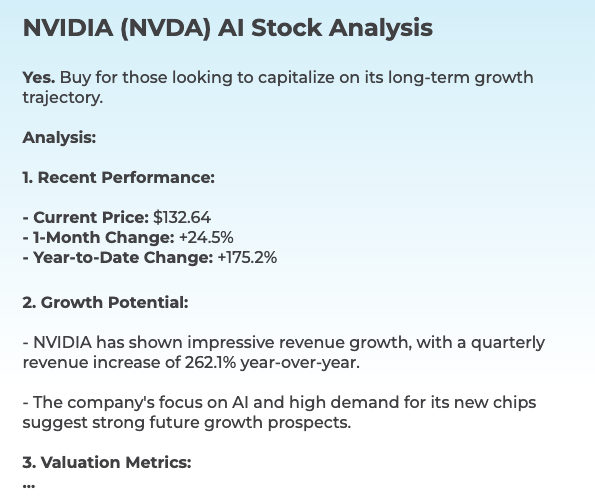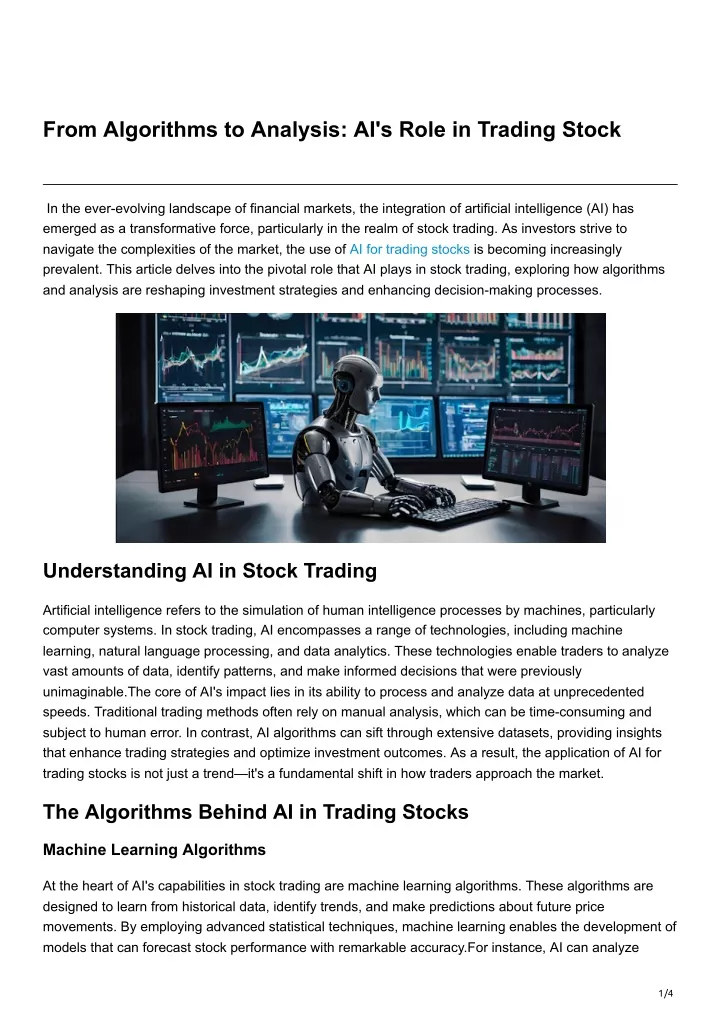20 Pro Pieces Of Advice For Picking AI Stock Trading Sites
20 Pro Pieces Of Advice For Picking AI Stock Trading Sites
Blog Article
Top 10 Tips To Assess The Strategy Customization Of AI stock Trading Platforms
The ability to tailor the trading platform in accordance with your goals in trading as well as your tolerance for risk and the current market conditions is an essential feature of AI-based stock prediction and analysis trading platforms. A platform with a wide range of customization features will enhance your trading. Here are 10 tips for evaluating the flexibility of these platforms.
1. Evaluate Pre-Built Strategy Templates
Variety of templates: Determine whether the platform has a variety of already-designed trading strategies (e.g. day trading or swing investing, long-term investment).
Ease of use: Assess how easy it is to use and alter these templates to suit your needs.
Performance history: Verify that the platform contains historical data about performance for already-built strategic plans.
2. Create a custom strategy
Drag-and-drop tools: Select platforms with drag-and-drop interfaces which allow you to easily create customized strategies.
Coding options: For advanced users, check if the platform supports custom-written coding in proprietary scripting language (e.g. Python, R).
Flexibility - Ensure that the platform you select permits you to define rules for entry and exit, parameters to manage risk, and other key components of your strategic plan.
3. Check for Backtesting Capabilities
Historical data. Verify whether the platform can provide enough historical data in order to test the strategy.
Customizable parameter: Make sure you have the ability to adjust parameters while backtesting (e.g. indicators, timeframes).
Performance metrics: Find out whether the platform has detailed performance metrics (e.g. win rate, Sharpe ratio drawdown, etc.)) for strategies that have been tested back.
4. Evaluate Real-Time Strategy Testing
Paper trading: Check that the platform supports simulation and paper trading modes for testing strategies in real-time without taking risks with your capital.
Live testing - Check that you can test strategies with tiny amounts to test how they work.
Real-time adjustments: Determine whether strategies can be modified in real-time based on market conditions.
5. Examine the Integration using technical indicators
Libraries of indicators: Ensure that the platform has a full library of technical tools (e.g. MACD, RSI and moving averages).
Custom indicators: You should be able to develop or import your own indicators that you can utilize in your strategies.
Find out if you can combine several indicators to make more complex strategies.
6. Check for Risk Management Tools
Stop-loss/take-profit: Ensure the platform allows you to set stop-loss and take-profit levels within your strategies.
Position sizing: Check if you can define the rules for sizing your position (e.g., fixed amount, percentage of portfolio) to control risk.
Risk-reward: Find out if your platform allows you to define risk-rewards for each strategy or trade.
7. Evaluate Multi-Asset Strategy Support
Asset classes: Make sure that the platform can support strategies in multiple asset classes (e.g. stocks, ETFs or options or forex).
Cross-assets strategies: Discover whether you're capable of designing strategies that combine different asset classes.
Market coverage: Ensure that the platform you're interested in covers the markets that are of interest to you (e.g. US or international, copyright).
8. Review Automation & Execution
Automated trading - Make sure that the platform is capable of automating strategies based on the predefined rules.
Types of orders: Check to see if the platform allows for different order types (e.g. limit or market) in the course of executing a strategy.
Latency: Make sure that the platform can make trades swiftly, particularly for trading strategies that use high-frequency.
9. Check for Strategy Optimization Tools
Parameter Optimization: Make sure whether the platform provides tools to optimize the parameters of strategies (e.g. genetic algorithms grid search, genetic algorithms).
Machine Learning Integration: Find out whether a platform incorporates machine-learning to improve and refine strategy.
Analyze scenarios: Determine if the platform allows you to test various strategies under different market conditions (e.g. bear bull, bear, volatile).
10. Review User Feedback and Community Support
User feedback: Conduct user research to determine the efficacy of the platform for customizing strategy.
Community forums: Check whether you can locate a forum where users discuss and share custom strategies.
Support resources: Ensure that the platform has tutorials, webinars, or documents that will help users develop and enhance their strategies.
Bonus Tips
Trial period: Take advantage of an unpaid trial or demo to try out the platform's and customization capabilities.
Scalability: Ensure that the platform is able to handle complex strategies that evolve when you trade.
Customer Support: Ensure that the platform offers assistance for any concerns related to strategy or questions.
These tips will help you assess the options for customization of AI trading platforms that can predict or analyze the performance of stocks. So you can choose one that matches your objectives in trading which allows you to refine and implement strategies. A platform with powerful customization options will allow you to adapt to the changing market conditions and enhance your results. Follow the top more info about trading ai for website advice including AI stock trading, ai trading tools, investing ai, options ai, trading with ai, ai investment app, ai for investment, chatgpt copyright, ai trade, ai investment platform and more.
Top 10 Tips For Evaluating The Scaleability Ai Platform For Predicting/Analyzing Trade Platforms
Scalability is a key factor in determining whether AI-driven platforms for stock forecasting and trading are able to handle growing demand from users, increasing markets and data volumes. Here are 10 best suggestions for evaluating the scaleability.
1. Evaluate Data Handling Capacity
Tips: Ensure that the platform you're considering is able to handle and analyze large datasets.
Why is that? Scalable platforms must be able to handle the growing amounts of data with no loss.
2. Test Real-Time Processing Skills
Find out the way the platform handles real-time data streams, such as stock prices and breaking news.
Reason: Delays in trading decisions can lead to missed opportunities.
3. Cloud Infrastructure and Elasticity The Cloud Infrastructure and Elasticity
Tip: Find out if the platform can dynamically scale resources, and if it uses cloud infrastructure (e.g. AWS Cloud, Google Cloud, Azure).
Why? Cloud platforms are elastic, and are able to be scalable up or down according to demand.
4. Examine Algorithm Efficiency
Tips: Evaluate the computational efficacy (e.g. deep learning and reinforcement-learning) of the AI models used for prediction.
The reason is that complex algorithms consume a lot of energy. So, optimizing them will aid in scaling.
5. Examine Parallel Processing and Distributed Computing
Make sure the platform is using parallel computing or distributed computing frameworks.
Why: These technologies enable more efficient data processing and analysis across a variety of nodes.
6. Examine API Integration and Interoperability
Tips: Make sure to check the integration of the platform with external APIs.
Why: The platform can adapt to changing markets and sources of data due to the seamless integration.
7. Analyze User Load Handling
To test the effectiveness of your platform, you can simulate high-traffic.
Why is that a platform that can scale should be able to keep up with performance when users grow.
8. Assessment of Model Retraining and adaptability
Tip Assess how frequently the AI models are retrained on new data.
Why: Models must constantly adjust to changing markets in order to remain accurate.
9. Check Fault Tolerance (Fault Tolerance) and Redundancy
Tip - Make sure that your platform has redundancy and failover mechanisms for dealing with hardware or software failures.
Why: Trading can be expensive So fault tolerance and scalability are vital.
10. Monitor Cost Efficiency
Examine the costs of scaling up the platform. This includes cloud resources, data storage, as in addition to computational power.
Why is it important to keep a balanced balance between expenses and performance costs.
Bonus Tip: Future-proofing
Be sure that the platform is able to adjust to changes in regulations and incorporates new technologies, like quantum computing, or even advanced NLP.
You can evaluate the capacity and effectiveness of AI trading and stock prediction systems by paying attention to this particular aspect. This will help ensure that they're efficient as well as robust and ready for growth. Read the best ai copyright signals for site tips including invest ai, ai software stocks, free AI stock picker, ai software stocks, ai options, best AI stocks, how to use ai for stock trading, best ai for stock trading, ai in stock market, stocks ai and more.